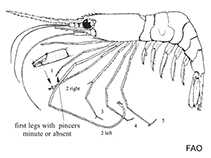Pandalus jordani Rathbun, 1902
Ocean shrimp| Native range | All suitable habitat | Point map | Year 2050 |

|
| This map was computer-generated and has not yet been reviewed. |
| Pandalus jordani AquaMaps Data sources: GBIF OBIS |
Upload your photos
Google image | No image available for this species;
drawing shows typical species in Pandalidae.
Google image | No image available for this species;
drawing shows typical species in Pandalidae.
Classification / Names Common names | Synonyms | CoL | ITIS | WoRMS
Malacostraca | Decapoda | Pandalidae
Environment: milieu / climate zone / depth range / distribution range Ecology
Benthic; depth range 36 - 457 m (Ref. 82649), usually 110 - 183 m (Ref. 82651). Tropical; 6°C - 12°C (Ref. 82649); 62°N - 28°N, 53°E - 114°W
Distribution Countries | FAO areas | Ecosystems | Occurrences | Introductions
Eastern Pacific and Northwest Atlantic: Alaska to Baja California, Mexico. Tropical to temperate.
Length at first maturity / Size / Weight / Age
Maturity: Lm ? range ? - ? cm Max length : 3.0 cm CL male/unsexed; (Ref. 82649); max. reported age: 4 years
The Oregon pink shrimp fishery of this species has been certified by the Marine Stewardship Council (http://www.msc.org/) as well-managed and sustainable (http://www.msc.org/html/content_1433.htm).
Life cycle and mating behavior Maturity | Reproduction | Spawning | Eggs | Fecundity | Larvae
Species is protandric hermaphrodites. Only one brood is produced every year (Ref. 82649). It matures first as a male at approximately 18 months and sex change occurs the following year where they spend the rest of their lives as females. Spawning began early in November. Ovigerous females lasted from late November to early April, eggs hatched in late March and early April (Ref. 85262).
Main reference
References | Coordinator | Collaborators
Dahlstrom, W.A. 1970. (Ref. 82649)
IUCN Red List Status (Ref. 130435: Version 2024-1)
CITES status (Ref. 108899)
Not Evaluated
CMS (Ref. 116361)
Not Evaluated
Threat to humans
Human uses
Fisheries: commercial
FAO - Fisheries: landings | FishSource | Sea Around Us
Tools
More information
Trophic Ecology
Ecology
Population dynamics
Life cycle
Distribution
Human Related
Aquaculture profile
Stamps, Coins Misc.
Stamps, Coins Misc.
Outreach
Taxonomy
References
Internet sources
Alien/Invasive Species database | BHL | BOLD Systems | CISTI | DiscoverLife | FAO(Fisheries: ; publication : search) | Fishipedia | GenBank (genome, nucleotide) | GloBI | Gomexsi | Google Books | Google Scholar | Google | PubMed | Tree of Life | Wikipedia (Go, Search) | Zoological Record
Estimates based on models
Preferred temperature
(Ref. 115969): 4.6 - 7.4, mean 5.8 (based on 83 cells).
Resilience
(Ref. 69278):
High, minimum population doubling time less than 15 months (K=0.51-0.7; tmax=4).
Prior r = 0.54, 95% CL = 0.36 - 0.82, Based on 3 data-limited stock assessments.
Nutrients : Calcium = 109 [35, 184] mg/100g; Iron = 1.59 [1.21, 1.97] mg/100g; Protein = 20.2 [19.2, 21.3] %; Omega3 = 0.285 [0.185, 0.386] g/100g; Selenium = 48.3 [-31.7, 128.3] μg/100g; VitaminA = 0 μg/100g; Zinc = 1.79 [1.17, 2.40] mg/100g (wet weight); based on nutrient studies.



